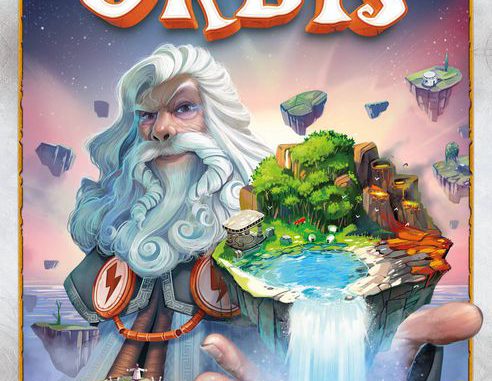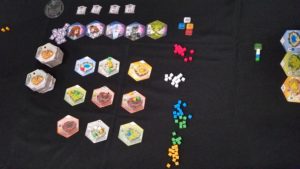
I demoed some more games for Asmodee at the Game Theory Expo back in September. There I got to try out a new game that hadn’t been released yet (but is now) called Orbis. I had quite a lot of fun trying it out so I thought I’d give you all a quick summary.
The premise of the game is you are trying to gain the favor of a god. You do this by building a pyramid of hexagonal land tiles that are worth victory points. Yeah, the premise sounds weird when you describe it in relation to game mechanics. So we’re just going to move on.
 Now, the mechanics of the game are straightforward. Each turn, you select a tile to add to your land. You are building a pyramid (a triangle really, but pyramid sounds better for some reason) of tiles. The bottom row is five tiles wide, then four, three, two and at the top you place a tile representing the god you are serving. This results in 15 total tiles collected, meaning the game runs exactly 15 rounds.
Now, the mechanics of the game are straightforward. Each turn, you select a tile to add to your land. You are building a pyramid (a triangle really, but pyramid sounds better for some reason) of tiles. The bottom row is five tiles wide, then four, three, two and at the top you place a tile representing the god you are serving. This results in 15 total tiles collected, meaning the game runs exactly 15 rounds.
Each tile is a hexagon of one of five colors (red, blue, white, yellow, green). When you pick up a tile, you add it to your pyramid. You can add it on the bottom row adjacent to any other tile. If you want to add the tile to any row above the bottom, it must be placed above a tile of a matching color. This means if you build your bottom row with two blues, two reds and a yellow, you can’t put a green or white tile in your second row. As you build up, your choices become more limited.
Now, how do you determine what tiles to pick up? Each tile does different things, most providing different amounts of victory points if you achieve certain goals. Achieving the goals on the tiles is the main driver for helping you decide what tiles to pick up.
For example, green tiles award points if they are placed with a certain number of tiles of a particular color combination around them (above and below). Conversely, blue tiles award points if they are placed on top of a particular color (in addition to being placed on top of another blue). Red tiles award points if you destroy resources on the board when you pick them up (more on resources later). White tiles award bonus points at the end depending on how many white tiles you have. Yellow tiles often award points for destroying your own resources.
 Further, at the top of your pyramid, each player will place their chosen god. Each god also carries a special benefit, often in the form of extra victory points if you accomplish a particular goal. For example, the green tree goddess awards you bonus points if you receive the most points from green tiles. The gods are laid out the beginning of the game and players can claim theirs at any time as their turn. When you decide to do this is an important part of the strategy. Do it too early and everyone knows your goal and can try to thwart you. Do it too late, and the one you wanted might get swiped.
Further, at the top of your pyramid, each player will place their chosen god. Each god also carries a special benefit, often in the form of extra victory points if you accomplish a particular goal. For example, the green tree goddess awards you bonus points if you receive the most points from green tiles. The gods are laid out the beginning of the game and players can claim theirs at any time as their turn. When you decide to do this is an important part of the strategy. Do it too early and everyone knows your goal and can try to thwart you. Do it too late, and the one you wanted might get swiped.
Waiting for the opportune moment to select your god is also important because, beyond some of the early tiles, all tiles require a cost in resources to collect. If you don’t have the resources for any of the tiles on the board, you can either take your god, or select a tile, flip it over, and play it as a grey tile which is worth negative points. However, grey tiles also count as every other color tile for the purposes of building. Sometimes its worth the negative points to be able to change your color options (remember, you have to have a matching color below a tile to build it).
So where do resources come from? Early on, most of the tiles cost no resources to collect, award no victory points but do give you some resources when you pick them up. The primary method of resource acquisition, however, is that when you pick up a tile, you put resources matching that color on adjacent tiles left in the play area. In the example picture above, if you pick up the yellow tile in the upper right-hand corner, it will cost you no resources. You would then put a yellow token on the adjacent red and white tiles. Whoever picks up those tiles, gets those resources.
There are also some that award you a token worth infinity of a particular color. These are highly sought after tiles and can make a huge difference in the game.
Overall, the game plays a bit like Splendor or Seven Wonders: Duel. All information is public. Winning requires a concerted strategy but it’s also not something you can plan out several turns in advance. The tile you want to pick up next turn might be gone. It’s also a low-pressure kind of strategy. Each turn you only have to make one decision: which tile do I pick up? It was a lot of fun and played pretty quickly once we got the hang of it. A good family game.


